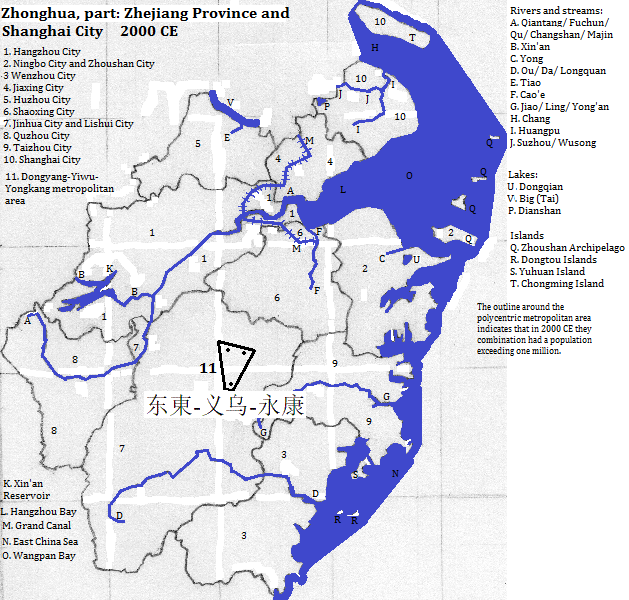金华 (Jīnhuá)
金华1 (Jīnhuá) is a city formally centered on the right (north) bank of the Jinhua River, a tributary of the Qu, in 浙江2 (Zhèjiāng) Province, in 中华3 (Zhōnghuá) People's Republic. Traditionally the prefect's population center has been further east. Only in the 20th century did any conurbation within the prefect have a large population (2010 metropolitan population of 4.400 million).4 The tallest building in the prefectural city (as of early winter 2016) is in 义乌 (Yìwū): the Yìwū Communications Development Building (381 feet).5
| Year | Name | Population | Political entity |
| 2000 CE | 东阳-义乌-永康 (Dōngyáng-Yìwū-Yŏngkāng) | 2,223,0006| 中华 (Zhōnghuá or Chinese) People's Republic) | |
Historical Map

External references
Skyline of Jīnhuá, Zhèjiāng Province, Zhōnghuá People's Republic
Footnotes
1. Jīnhuá or Chin-hua or Jinhwa are transliterations from Pŭtōnghuà Chinese. The first character means gold and the second Chinese/ illustrious/ flowery. I do not know how it would transliterated from the local Wu dialect. Prior to this century the prefectural level shi's center was distinct from the triple cities (county level shi) of 义乌 (Yìwū or I-wu or Yiwu or Iwu), 东阳 (Dōngyáng or Tung-yang or Dungyang) and 永康 (Yŏngkāng or Yung-k'ang or Yungkang) that together constituted a metropolitan area; now those three are subordinate to the prefectural shi. 义 means righteous, 乌 means crow. 东 means east; 阳 means male. 永 means flowing-water or eternal; 康 means peaceful/ quiet/ happy/ healthy. I do not know the Wu dialect group's transliteration of these three cities.
2. Zhèjiāng or Che-Chiang or Jejyang in transliterated Pŭtōnghuà Chinese. It is also called Chekiang (former postal designation based on the Nanjing dialect). The first character is a phonetic marker coupled with the water radical. In reconstructed Old Chinese it was pronounced like tet, and was a proto-Wu term for the Yue people according to https://en.wikipedia.org/wiki/Zhejiang, accessed August 10, 2016. The second character means river.
3. Zhōnghuá or Chung-hua or Junghwa in transliterated Pŭtōnghuà Chinese. The first character means central and the second means Chinese/ illustrious/ flowery. China is its English name. In the Wu dialect group it transliterates as Tsonkoh.
4. The shi had 5.362 million according to the 2010 census. Omitting the three xiàn reduces this to 4.400 million. (2010 census figures are from https://en.wikipedia.org/wiki/Jinhua, accessed July 31, 2016.)
5. emporis.com, accessed Dec. 8, 2016.
6. https://www.citypopulation.de/php/china-zhejiang-admin.php (accessed Aug. 2, 2016 (and again on Dec. 8, 2016) provided the prefectural and sub-prefectural populations for 2000. https://en.wikipedia.org/wiki/List_of_administrative_divisions_of_Zhejiang, accessed on the same early date provided the list of administrative changes 2000 to date. Jindong District was at that time just a county (Jinhua County), and thus acted as a separator between the small city center of the Wucheng District and the tri-city metropolitan area to Jindong's east. Those three together created a metropolitan population of 2.223 million, with the prefectural-level shi with everything included having 4.572 million in 2000 CE.

